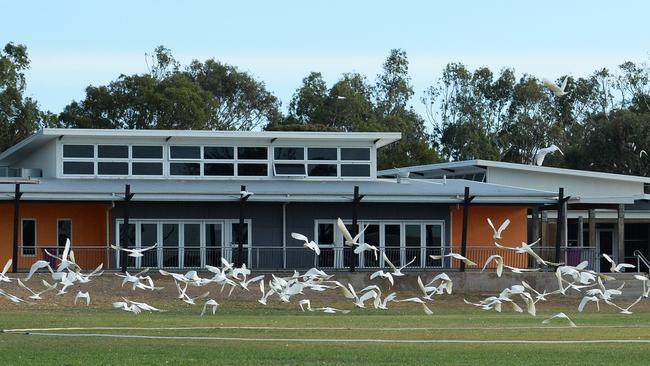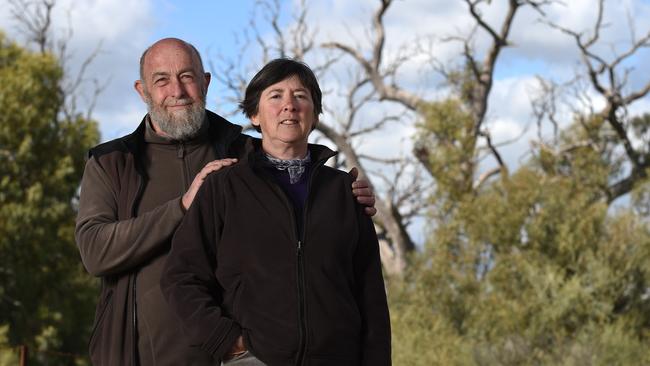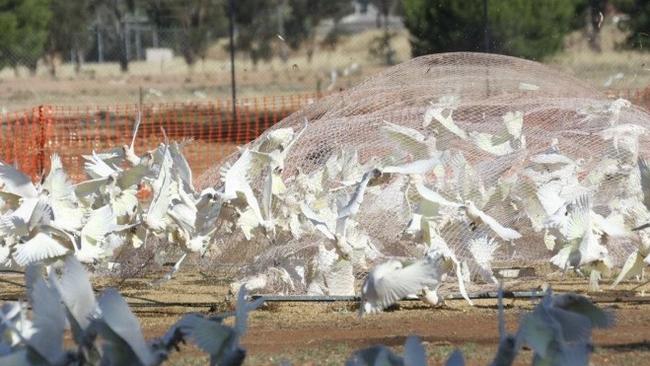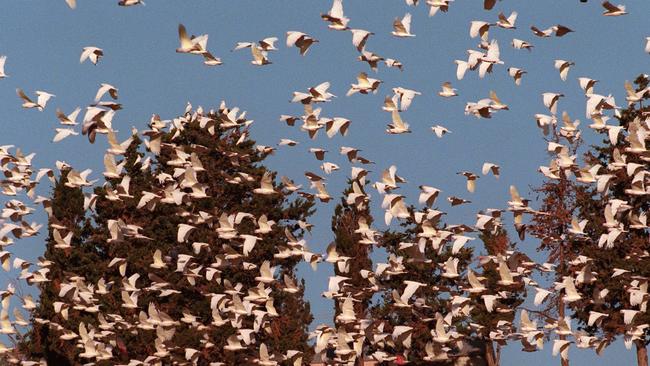Corellas wreak havoc across state
SMALL by name but a big menace to flora, fauna and civic property, the little corella is causing a squawk in the town and country. | Watch the video
SA News
Don't miss out on the headlines from SA News. Followed categories will be added to My News.
IT IS the secret civil war on South Australian soil that began soon after white settlement and shows no sign of abating despite millions of lives lost. We’ve shot, clubbed, poisoned, drugged, trapped and gassed the enemy.
We’ve conducted chemical warfare and inflicted severe psychological torture — through the use of flashing lights, loud music and large explosions — sufficient to scare the very life from their bodies.
But the resilient little corella has shown little sign of retreat across the state despite an increasingly aggressive campaign to move them on or destroy them.
In settlements from the Flinders Ranges to Mt Gambier, large flocks of corellas have caused expensive carnage for councils and businesses, ripping up newly installed equipment, peeling off paint, denuding historic trees and depositing mountains of faeces and feathers.
The cost is incalculable. And experts claim this spring — the breeding time when numbers swell rapidly — the conflict is intensifying, especially because significant flocks have recently taken up residence in the city and inner suburbs. Perhaps the greatest indication this is total war is that little corella — with the graphic alternative name of the bloodstained cockatoo — are not protected in Australia.
Gary Lucas, a declared environmentalist who runs the Quorn Caravan Park in the Flinders Ranges with wife Bronwyn, has shot more than 2000 birds in the past three years. The killing or culling — depending on your view — hardly made a dent in the large flocks prevalent in the region but he has found shooting so successful in moving the birds on he has effectively put down his shotgun this year.
“I don’t like killing anything but this is a problem caused by humans and we are the ones that have to do something about it,” Lucas, intent on saving over 200 river red gums on his property, says.
“I’m supporting the trees and not the corellas because you can’t do both, not unless you like dead river red gums.
“At their peak we had a flock of around 60,000 around here and they’ve killed most of the big trees through town.
“There are lots of people who hate them up here — it’s the norm.”

No other bird — not even the humble unloved pigeon forever condemned as rats with wings — raises the ire or stirs protective passions like the Cacatua Sanguinea, one of 14 species of cockatoos in the subfamily of Cacatuidae native to Australia.
Opponents say they are destructive, dirty and noisy and can be detrimental to human health, causing depression, anxiety and illness, while proponents claim the birds were here first and humanity needs to find a way to harmonise with them.
Close cousin, the long billed corella and other species known collectively as “white parrots” including sulphur crested cockatoos and silver gulls, do have protections but, alongside the galah, the little corella is listed on Schedule 10 of the National Parks and Wildlife Act.
That means they are unprotected and you do not require a permit to kill as many of them — by shooting — as you choose.
Of course, you still need to abide by the firearms act and the animal welfare act which will definitely prohibit you from firing wantonly across your local footy oval but if you own a few acres in the hills or beyond you are permitted to blast away with relative impunity.
Birds are killed by 12-gauge shotgun with the code of practice specifying the rules of engagement for shot size, distance of shot, and the requirement to shoot to kill. You cannot shoot into the middle of the flock, only at the fringes to knock off the stragglers.
Mike Greig, a Senior Ecologist Abundant Species and Sustainable Use, with the Department of Environment, Water and Natural Resources (DEWNR) advocates shooting is “no magic bullet” when it comes to controlling corellas, but culling is a recommended control.
“Corella management is a complex and difficult problem because it’s almost impossible to permanently resolve,” he says. “A long term approach will deliver dividends and shooting remains part of the mix but should be at the end of the process of strategies because, if that doesn’t work, all you are left with is getting a bigger gun.”

Gary Lucas says getting the “big artillery” out has worked for him and he has shot no more than 40 birds this year as they have “got the message.”
“Corellas are very intelligent, social birds that live for a long time and pair for life and they’ve become accustomed to human behaviour and adjust accordingly,” Lucas adds. “They learn to recognise the danger signs. One year I changed my hat and they didn’t recognise me anymore so I could get up much closer and clear them out along the creek.”
During nine years on the Flinders Ranges Council, Lucas committed to spending three weeks of his own time trying to get the corellas out of town using, among other methods, gas operated scare guns that make a loud noise and go off at intermittent intervals.
“I wasn’t very successful though despite spending around $6000 in time and resources,” he adds. “You’d have to keep it up for six months to see a difference and rural councils don’t have those resources.”
Flinders Ranges Mayor, Peter Slattery says his council is looking to the state government for co-ordinated assistance and is joining with other councils to fund research programs to better understand problems and address them.
“If you look at what Willunga High School did this year (spending a reported $50,000 to address over $100,000 damage to sports courts) that amount is over 10 per cent of our council’s annual budget. And we don’t just want to push the problem somewhere else because when we get them to Melrose they’ll just kill their trees.”
Ronel Git from Ecosure, one of the nation’s largest specialised ecological consultancies working with more than 60 airports in Australia on animal risk mitigation programs, agrees corellas are not “birdbrains”, calling white parrots the “apes” of the avian world.

An environmental scientist focusing on ecology, Git works on control programs at Edinburgh air base in Adelaide’s north, where a birdstrike could cause a catastrophic accident.
He sought clearance from the Department of Defence — that spends millions of dollars annually on national bird management — to speak on the subject.
“They’re actually very intelligent birds with large skulls that rapidly adapt to changes in environment,” he says. “They are unique in the bird kingdom in that they use their jaw muscles like a Swiss Army knife that enables them to chew and crush at the same time. They also have two toes looking forward and two backwards on each leg which equates to eight fingers to hold things with.”
Corellas are playful, if not plain naughty, and when not eating are always looking for ways to entertain themselves.
That might be ripping out nails from roofing tiles, or picking out the rubber on a car windscreen or greenhouse or stripping the bark from gum trees. At footy ovals they pick away at plastic light cabling or strip paint from picnic benches.
Git says in the natural world corella beaks would have been maintained as they foraged for food and combated the extreme environs to find it, but the wide availability of food, especially soft grain, has led to other activities to help maintain beak strength and health.
Humans have been battling bird populations well before large scale agricultural cropping began in the 19th century. In 1424 King James I of Scotland introduced an Act for the destruction of rooks that were compromising harvest yields, while the English Huswife, written in 1668 by Gervase Markham, included a chapter on techniques to minimise damage to crops and orchards from birds.

IN SOUTH Australia, settlers have been managing and moulding the landscape since proclamation in 1836; coincidentally the environments we create suit ideally the needs of the white parrots. They enjoy open grassed lawn, large trees to roost in, permanent sources of water and access to grain.
Little wonder communities like Strathalbyn — with a large flour mill nearby — have been inundated with the birds.
Git claims the solution to bird management is not trying to “dictate to nature” but researching widely to “know your opponent” and finding integrated solutions to issues.
“There is a perception this problem is increasing but flocks of 60,000 birds were commonplace in the early 1800s. It’s just that the birds are more conspicuous now because we have cleared so much of their habitat,” he says. “The other thing is we are in the middle of strong El Niño (warming phase) again which is creating extreme drought in the north so the birds are learning to stay further south and for far longer periods.”
He warns going to war with the birds will prove futile. “These birds can get desperate in periods of drought or food shortage and you will just have to keep killing them by whatever means available to keep them away — but killing them is not easy, it’s bloody and ultimately ineffective,” he adds.
“Every bird has its weaknesses and sometimes it is as simple as the length of type of grass being used in an area. Corellas don’t enjoy taller grass where they can’t see ahead and watering in the morning or at night can also make grassland areas less attractive to birds.”
Another major intervention Ecosure uses at airports is not allowing scouting flocks — often just a few hundred birds — to settle in an area where they encourage the main flock to join through sophisticated call signs. Each flock has a unique call, which is a large part of why the birds are so noisy, constantly chatting and gossiping.
Stock whips are used at Edinburgh air base to move on scouting birds that find the shock wave particularly distressing. The man charged with combating birds says he has great respect for his opponent but the issues must be addressed.
“If you fail to control bird numbers then they can damage the environment for other bird species,” Git says. “Big trees are rare and the hollows are only created by termites. People will have probably noticed less parrots in the Mt Lofty Ranges which have been largely undamaged by fire for over a decade. Fire damages trees and weakens limbs allowing a fungus to develop which attracts termites and they create the nesting hollows.”
The dearth of suitable nesting habitat in the hills has resulted in an influx of birds coming down on to the Adelaide plain where they are increasingly seen in large flocks on school ovals and football grounds.
Maree Smith, who founded the Friends of Little Corellas Group in 2003 in response to a concerted effort to reduce corella numbers by Onkaparinga Council, believes large numbers of parrots in the city surrounds will see the issues flare up bigger than ever before.
“What we need is an accurate statewide count — if we had 10,000 birds and 10,000 trees we’d never see a bird,” she says.
“We are denuding the landscape and then blaming the birds that are flocking together because they have nowhere left — we are to blame.
“There is a lot of hysteria around the issue and if they (birds) are getting closer to the city that will only increase calls to cull even more.”
THE Onkaparinga Council — that, with a number of other councils, has expressed frustration with a lack of state government resources and assistance to deal with the issues — helped fund the report regarded as “the bible” of corella management practices.
Completed in 2010, Managing impacts of the Little Corella on the Fleurieu Peninsula, by wildlife specialist and Churchill Fellow, Ian Temby, was jointly funded by the City of Onkaparinga, DEWNR, Mt Lofty Ranges Natural Resources Management Board, South Australian Murray Darling Basin Natural Resources Management Board and Alexandrina Council.
The report details that a sustained strategic approach — using a wide variety of measures — can successfully reduce bird numbers from a specified area.
Smith says corella numbers around Old Noarlunga are down considerably over the past decade and that culling is the main reason. “There are only a few around because of the continuous culling,” she says. “They’ve also cleared hundreds of almonds trees around here to stop them coming in. If you want to live without animals you might as well be in a concrete city.” Smith, who claims a passion for all wildlife, received worldwide support for her campaign to stop the culling in 2003.
“The corellas are the biggest tourist attraction for the region and we were inundated with protests from around the world. People were so horrified they threatened to boycott McLaren Vale wines,” she says. “I was mortified to see the council shooting and clubbing to death birds in a public park; it was so barbaric. But gassing (by carbon monoxide) is even worse it’s such a horrible cruel death they snap wings and legs off. The large culls are often hidden from the public but Onkaparinga made the mistake of exposing themselves.
“But culling off just one species will cause other environmental issues — we need a balanced environment and these birds are only trying to survive.”
Ms Smith could raise a notorious episode from the Chinese Cultural Revolution to demonstrate her point. In the spring of 1958 the central government of China issued a decree the nation participate in the national campaign to eliminate “The Four Harms”.
One of these “great evils” of the nation was the humble sparrow believed to be decimating crop harvests. To eradicate the sparrow population the nation was organised to create enough noise — mainly from the banging of pans and drums and blowing whistles — to frighten and scatter the sparrows from their normal roosts.
The order was to pursue them until they literally dropped down dead from exhaustion. The meticulously planned “Slaughter of Sparrows” campaign began precisely on schedule at 9am on the morning of April 20, 1958.
It proved a great success in recording a spectacular decrease in the sparrow population throughout China, but there was a disastrous consequence the following year, when, without a natural predator, insect numbers multiplied dramatically.
The great famine of 1959 followed when China’s crops throughout the whole country were devastated causing enormous nationwide suffering for the next three long years resulting in the deaths of millions.
The Sparrow War was officially called off two years after it began in April, 1960.
If that wasn’t warning enough Australia has its own example of the futility of going to war with a bird. Despite the deployment of the Australian Regular Army that machine gunned flocks of three-toed Dromaius, the Emu War of 1932 was decisively won by ... the emu.
Following the long hot summer of 1932, wild emus in the far reaches of Western Australia went on the rampage in search of food and water. Farmers feared for their crops and, in a bid to stop the advancing emu army along the rabbit-proof fence, they enlisted the help of the army.
Armed with two automated Lewis machine guns and 10,000 rounds of ammunition, a party of 30 men, led by Major Meredith of the Royal Australian Artillery, was sent to confront an estimated 20,000 emus. Six days after the first engagement — and despite both guns jamming regularly — more than 2500 rounds of ammunition had been fired. But less than 100 birds lay dead.
The major’s official report noted that his men had suffered “no casualties”.
The major wrote in his extensive explanation of the humiliating defeat: “If we had a military division with the bullet-carrying capacity of these birds it would face any army in the world. They could face machine guns with the invulnerability of tanks. They are like Zulus ...”
Less than a week after the Emu War began, Labor Defence Minister, George Pearce, ordered a full withdrawal. The action prompted a rowdy debate in the House of Representatives, which included the question from an opposition MP, ‘Is a medal to be struck for this war?”.
THERE may be some rational explanation for those that hate birds — they can carry disease including the deadly avian flu — but no other cultural event in the past 60 years has elevated fears of feathered creatures greater than Alfred Hitchcock’s classic 1963 film The Birds .
Based on Daphne Du Maurier’s novella, originally published in a 1952 issue of Good Housekeeping magazine, and a newspaper article Hitchcock read about thousands of sea birds washing up on the beachside streets of Capitola, in California, The Birds was unheralded by critics but left a lasting impression on audiences.
A fear or dislike of birds is inherent in large sections of the community and Hitchcock’s film played heavily on those instincts. He had a great respect and appreciation for birds and was a keen bird-watcher, known as a twitcher, in his youth but his fellow luminary film director Ingmar Bergman, had a full blown case of “ornithophobia” and despised even the smallest bird.
But whether you fear, loathe or love the little corella the evidence in South Australia is they are here to stay — and in large numbers.
You may be able to move them on if you supply their needs elsewhere but experts agree whatever strategy of management you adopt to lessen their impact “getting rid of the bird” will be the hardest and least successful option.
“Living sustainably with wildlife is a philosophy we believe everyone should adopt,” Mike Greig from DEWNR adds. “The positive aspects of wildlife should be appreciated so we can all live together.”
Ronel Git agrees the relationship between man and bird cannot be sustained on the extremes of love or hate.
“We need to use our logic, skill and knowledge to find great solutions for humans and birds to harmoniously coexist.” ●


